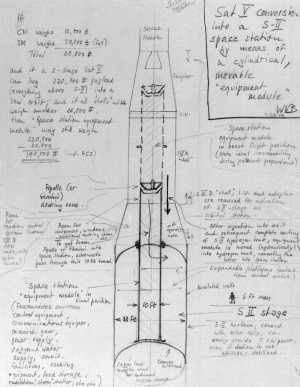In a merging of two of my great interests, NASA has issued a Request For Information (ROI) on how best to “analyze and catalog notes from spaceflight pioneer Wernher von Braun into an electronic, searchable database or other system.“

Sample Page from Von Braun's Notes
At first glance, this is something that would be solved by using library tools and software. However, the list of potential ways to set this up seems to illustrate the gaps in library technology (all points are mine):
- Users should be able to see the notes as they exist.
- The text in the notes, as well as all labels and notations, should be fully keyword searchable.
- All elements of the notes, including text, formulas, diagrams, etc. should be able to be targeted and described in a way that allows for keyword searching. This includes “tagging”, but also commentary, description and critique.
- Users should be able to define relationships (create links) between ideas within the notes, as well as documents and other resources from other collections. For instance, someone seeking information on the Saturn V Engine Bell should find all drawings, notes, diagrams, and formulas within the notes, as well as outside resources relating to all of these.
This project begs for a combination of a traditional database (for storing and searching text) with the added functionality provided by social software products. Nothing in the list is beyond the current means of technology… think of a wiki combined with flickr-type functionality that can utilize PDF documents and you have a good starting point.
Why hasn’t this been done? How many libraries and archives have document sets like this that could become a researcher’s favorite collection, with the right application of technology? Have any been digitized with a social annotation feature?
Why do I suspect that the development of this will come from outside the library community? We should already have projects that utilize this kind of mash-up philosophy… our collections could be so much more powerful.
There are some great things being done in the library technology realm, and many people and projects that are worth praising. But now and then I see something like this and wonder how we missed this obvious application of existing technologies.
found via ResourceShelf and Wired Science

